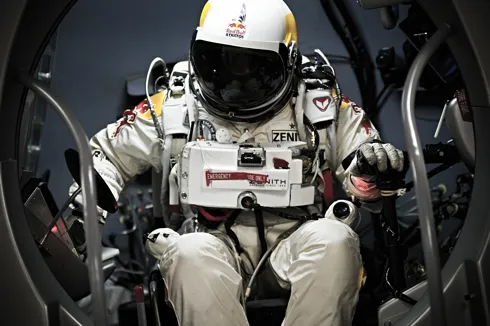Believe it or not, the mission is all about safety. A man will jump from a helium balloon halfway to the edge of space. He’ll hurtle head-first through an environment that, without protection, would kill him in 14 seconds. At 120,000ft there will be no air resistance to slow him down, so he’ll tear through the sound barrier in less than half a minute. He will become the first person to go supersonic without the aid of a jet engine. Twenty minutes later – assuming he isn’t dead – the man will be back on Earth and in the record books. But it’s exactly how he safely completes the freefall that is the key reason for making the jump.
The man’s name is Felix Baumgartner, and he’s not your average thrill-seeker. The 42-year-old Austrian has made a living courting and defying death. In 1999, he made the lowest BASE jump in history, off the outstretched arm of Christ the Redeemer in Rio de Janeiro; in 2003, he ‘flew’ across the English Channel with a carbon-fibre wing strapped to his back. The words ‘Born To Fly’ are tattooed on his right forearm.

Baumgartner is a test pilot – he just doesn’t have a vehicle. And for his next stunt, he will be testing the human body and equipment designed to protect it in the lethal environment of the stratosphere, the second layer of the Earth’s atmosphere, which stretches from around 30,000 to over 150,000ft above the Earth. Given that several have died trying to dive from such heights, it would be easy to characterise Baumgartner as a reckless daredevil, but he’s the opposite: inquisitive, calculating, methodical. “I’m a very careful planner,” he says. If Baumgartner is successful, he’ll record the longest freefall in history, the highest manned balloon flight and the highest parachute jump.
The jump, named Red Bull Stratos after the energy drinks manufacturer that conceived of and is backing the mission, is about more than just bragging rights. The data collected about Baumgartner’s body and the technology encased in his jump suit could be critical for the future of human spaceflight.
To reach the stratosphere without a rocket, you need a balloon – a really big one. Baumgartner’s inflatable bag is made from 40 acres of polyethylene. He’ll be carried in a pressurised capsule below the balloon, which will be partially filled with helium, a lighter-than-air gas that will expand in the thinning atmosphere as the balloon rises. By the time it reachesits destination 37km (23 miles) up, the balloon itself will be the height of a 79-storey building.
Up in the air
The danger starts not miles above the Earth, but just after launch. “If the balloon breaks while the capsule is lower than 2,000ft, the recovery parachute doesn’t have time to open fully and slow the capsule down before it hits the ground,” explains Art Thompson, the Stratos technical director. “That’s known as the dead zone. We’re taking a risk there and Felix realises that if the balloon were to break there is a high probability of injury and possibly death.”
At just 0.02mm – about one-tenth the thickness of a sandwich bag – the balloon’s extra-thin material makes it susceptible to many things, including a gentle breeze. So the Stratos team will monitor the weather in fine detail before giving the okay for launch. Once the order is given, it’s just two or three hours to the roof of the world. Inside the 6m-diameter capsule (the exterior of which is based on NASA’s Gemini and Apollo spacecraft), Baumgartner will be busy the entire time, providing feedback to mission control about his condition and the state of the capsule.
Outside, the cold could reach a frosty –56ºC. But more dangerous is the pressure: at 120,000ft, there’s almost a total vacuum and the atmospheric pressure is roughly one per cent of what we experience at sea level. Baumgartner will have to equalise his ears like a scuba diver, the altitude making decompression sickness (‘the bends’) a real issue. As the air thins, nitrogen forms bubbles in the body.“It causes excruciating pain and at worst it can be lethal,” says Dr Andrew Murray of Cambridge University, a physiologist who specialises in extreme medicine and conducts studies at Everest. “If nitrogen gets into your coronary arteries you could die of a heart attack or a stroke if it reaches your brain.” To prevent this, Baumgartner will breathe 100 per cent oxygen during the mission and for an hour before to ‘wash out’ nitrogen from his body.
Sudden depressurisation could also kill him, and this is where the project’s real scientific merit comes in. The Stratos team has built a next-generation space suit, a pressurised capsule and biometric monitoring technology – all designed to keep Baumgartner alive. “The capsule will be pressurised to the equivalent of 16,000ft in altitude, and once he exits the capsule, Felix’s suit will be pressurised to the equivalent of 35,000ft,” says Dr Jonathan Clark, the team’s medical director.

If they work, the suit and capsule will prevent decompression sickness and ensure that Baumgartner doesn’t face the near-vacuum of the stratosphere. If the technology fails, he’s a dead man; he’ll be far above what’s known as the ‘Armstrong line’, which denotes the altitude where atmospheric pressure is so low that water boils at body temperature. The air inside his lungs would multiply over 100 times in volume and, if he tried to hold his breath, his lungs would rupture. Baumgartner would be dead in seconds, although his body would continue to expand into whatever space the suit allows.
Learning from leaping
Catastrophic loss of pressure has killed several high-altitude skydivers in the past. But one man on the Stratos team has already survived depressurisation at altitude: Joe Kittinger, a retired US Air Force colonel who holds the record for the highest parachute jump – a record that has stood for 52 years. Now 83, Kittinger will serve as the mission’s Capcom 1: Baumgartner’s primary contact for capsule communication with the ground team far below.
In 1960, Kittinger set his record – 102,000ft – while testing a new parachute system for the Air Force. Unlike the full-pressure suit Baumgartner will be testing, Kittinger’s suit had separate sections pressurising different parts of his body, including his hands and feet. “On the way up, the rubber tube connecting the right glove to the air source broke,” he says. “When I arrived at 40,000ft the suit was pressurised, the glove wasn’t.”Kittinger’s hand ballooned to more than twice its size, filling the glove and only returning to normal after a few hours on the ground. But because Baumgartner will wear a full-pressure suit, the loss of a glove would mean he’d lose all pressure. “If he lost a glove, he would be dead,” Kittinger explains.
Stratos will test the effectiveness of the new space suit. “As nobody has done this before, this data will be invaluable in advancing human space exploration,” says Jonathan Clark. “The monitoring system we use is also being evaluated for use on upcoming suborbital spaceflights. Commercial space companies are evaluating crew escape systems like the one we are using for their upcoming flight tests.”
Clark understands the potential benefit of the technology better than anyone: he was a NASA flight surgeon for years, as was his wife, Laurel. She was on-board the Space Shuttle Columbia when it broke up on re-entry to the Earth’s atmosphere in 2003, killing all seven crew members.

If the Stratos suit works, it could inform the design of suits worn by future astronauts, aviators and space tourists. By donning a similar suit and jumping, pilots and passengers could escape from a spacecraft mid-flight, saving themselves from the fate that befell the crew of the Columbia disaster. Based on a 71,500ft test jump in March, the Stratos team already know that someone can make a clean exit and maintain stability in the stratosphere. “It could be important information for researchers looking to establish emergency bailout protocols,” says Clark.
Provided the suit holds firm, the balloon flies true and there are no problems with the capsule, all that remains is, well, the gravity of the situation. The jump starts with a step through a circular door in the capsule onto a small platform. “At 120,000ft the air is so thin that if I have an unstable exit, I won’t be able to work against the air’s resistance for stabilisation,” says Baumgartner. A stable trajectory would stop him from spinning like a propeller. “A flat spin would essentially create a centrifuge out of his body,” says Dr Murray. “It would draw the blood away from his brain and he could start to lose consciousness.”

In the 1940s and 1950s, ejections from fighter aircraft resulted in pilots spinning at rates of 180-250rpm spins – all were fatal. If the centre of rotation is in the upper part of the body, blood rushes toward the feet, which can cause a blackout. And if the rotation is centred in the lower part, blood rushes toward the head, the effects of which range from a feeling of pressure to bleeding in the brain. “The longer the spin lasts, the more dangerous it becomes,” warns Clark.
In 1959, Kittinger experienced just such a spin. His drogue parachute – which adds drag and stability – deployed too early and wrapped around his neck, causing a flat spin at a rate of 120rpm. He blacked out, his life saved by the regular chute, which opened automatically at 10,000ft.
Should Baumgartner make an unstable exit and go into a spin, technology should also come to his aid. A device on his wrist will measure the G-forces on his body – if he experiences over 3.5G for more than six seconds his drogue chute will deploy automatically and stabilise his fall… provided it all works smoothly. However, the drogue chute would slow Baumgartner down and could rob him of becoming the first person to travel at supersonic speed – the biggest prize and a genuine scientific frontier. Nobody has fallen through the sound barrier before, so nobody knows what will happen.
One possibility is that shockwaves or sonic booms will be created as Baumgartner exceeds the speed of sound. When a supersonic jet breaks the sound barrier, it creates pressure waves in the air in front and behind it, like the ripples a boat creates on the surface of a lake. Eventually these waves collide, creating a single almighty shock wave and a crack like thunder. If that happens, there’s no way of knowing whether it will send Baumgartner spinning off course, rip his suit apart, or do nothing at all.
Whatever happens, the Stratos project will generate invaluable information for mankind if we’re to become a space-faring species. NASA may have grounded the Space Shuttle but its successor, the Orion programme, is set to carry astronauts back to the high frontier within a decade. And later this year, Richard Branson’s company Virgin Galactic will take its first space tourists to low-Earth orbit on the SpaceShipTwo space plane. Almost 10 years after the loss of Columbia, we’re still learning how to survive the risks involved.
“More people are going to be travelling to space and they will need new kinds of suits and safety procedures – hopefully, we are pioneers in developing something for their needs,” says Baumgartner. So believe it or not, when a man makes a death-defying jump from the stratosphere this summer, it’s all in the name of safety.
Follow Science Focus onTwitter,Facebook, Instagramand Flipboard
